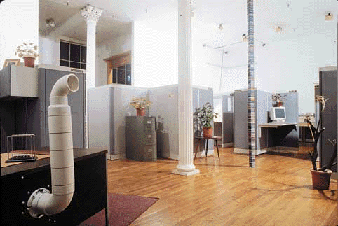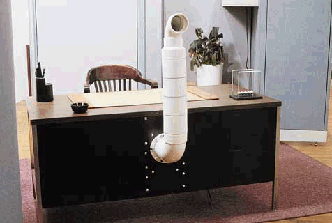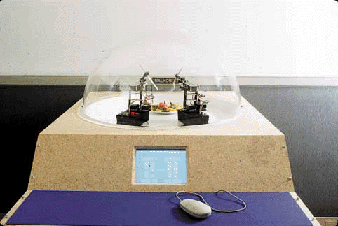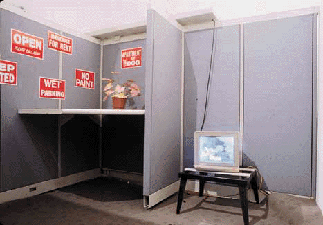
coping with technofatigue
by Robbin Murphy


|
technology can be exhausting for an artist "if every two years the tools of a painter went out of date and every painter had to re-train: if drawing paper suddenly became multi-dimensional, paintbrushes were motorized, and color-mixing was achieved by numerical operation!" Painting tools have gone through technical innovations over the centuries. Impressionism resulted, in part, from the relatively wide availability of commercially produced paint in tubes that were easily transported over the newly opened suburban railway lines to the countryside of Paris. Artists responded by inventing new techniques of painting. Georges Seurat took advantage of the new mobility in order to bring sketches done on the spot at La Grande Jatte back to his studio where he proceeded to produce paintings in a method that was based on an early Leonardo-esque scientific precision. Every artist has to come to terms with new technology, be it the introduction of oil paint in 15th Century Europe (that demanded artists know as much as chemists) or HTML in the present. The choices seem to be: reject, embrace or accommodate.  "Sorry, We're Open" at Postmasters Gallery 1. REJECT NEW TECHNOLOGIES The most obvious treatment for techno-fatigue is, of course, to stop trying to use computers to make art. Though this may sound simple, the ever increasing presence of computer technology in our daily lives may make this impossible and akin to the dilemma of earlier Conceptual artists who wanted to dematerialize the art object while still remaining visible within a commodity-based art world that demanded physical objects. Even if the object is completely analog, the context it is placed in will be, at least partially, digital. Rejecting digital technology may, in the future, create its own form of anti-techno-fatigue. The writer Thomas Pynchon--who seems to know more about technology than anyone these days--brought up the question of opposing technical innovation in his 1984 essay, "Is It O.K. to Be a Luddite?" In this essay, he looks back on C. P. Snow's famous 1959 lecture, "The Two Cultures and the Scientific Revolution," in which Snow warns about the growing polarization between "literary" and "scientific" cultures in the West, and concludes that in 1984 the distinction is meaningless because "demystification is the order of our day." Anybody who really wants the specialized knowledge of either camp can, with enough patience and determination, obtain it. The result has been, he claims, not a widening of the divide but a multiplying of cultures competing for our attention, giving us less time to sample outside our own specialty. Instead of two teams facing off against each other on a field that field is crowded with one-person teams each playing their own particular game. Snow saw literary intellectuals as "natural Luddites" uninterested in or incapable of understanding the Industrial Revolution the way scientific culture can. (Luddites were organized bands of men in the first decades of the nineteenth century who destroyed machinery in the textile industry.) Pynchon suggests that it is Snow who doesn't understand the Industrial Revolution because, with his scientific bias, he neglects to consider the social and cultural ramifications of technology along with the mechanical implications. He goes on to suggest that it may even be the "Luddites" who were more perceptive since they had seen how the machines were affecting daily life by putting people out of work and enriching the leisure class. The Luddites were, in Pynchon's term, the "Badass--the djinn, the golem, the hulk, the superhero--who will resist what otherwise would overwhelm us." People love them and will create them even when they don't serve as a form of self-protection. The irony now is that with computer and communications technology the Luddites and their foes find themselves in a common arena working in supposedly opposite directions. 1984 saw the birth of the Macintosh and the concept of personal computing that made the arena muddy and unbearable for those who prefer a cleanly divided battle with each side wearing their respective uniforms. By 1993 Penny would add a third term to the "literary vs. scientific" equation: consumer commodity economics. Artists are drawn to computer technology--if only because it's part of the culture and ripe for manipulation like any other part of culture. But even with the availability of computers and software most artists don't have contact with the labs where the technology is developed. A few do but in a way that discourages esthetic concerns (such as the MIT Media Lab). Like everyone else, they access the technology as a consumer commodity and the result of their work is part of that economic system, whether they like it or not. It's as if the Luddites had to use the very machinery they were destroying in order to do the smashing. It may seem obvious to us now that the best technology doesn't necessarily win out when it is created as a consumer commodity. Technological "progress" in this system is fueled by marketing and corporate profits rather than cultural or social needs. Anyone who uses Windows 95 will instinctively come to understand this. Penny uses the example of the automobile; he pints to the fact that its "user interface" was codified not because it was the best that could be designed but because a critical mass of consumers learned how to drive at that particular point. The dynamics of consumer culture decide which technological innovation will have legs, even if they're shaky. The losers will take up space in the closet.  Some artists have even managed to find fertile subject matter in the ruins of dead media. The artist Perry Hoberman recently recreated the Postmasters Gallery in New York into a virtual fantasyland of technology--turned both obsolete and berserk--that he called "Sorry, We're Open." In a SoHo loft space that could easily become an office space overnight, he installed modular office cubicles that had an uncanny resemblance to the standardized gray frame of the early Mosaic Web browser. Inmates of this office tried gallantly to customize their space with pictures, texts and fast food condiments while dropped ceilings threatened from above, computers performed meaningless repetitive tasks unassisted and floppy disks from extinct platforms created a column of inaccessible information on the floor. Hoberman's simulated corporate computerized dystopia was made even more "real" by the fact that many of the computers were only hollow plastic dummies placed there to create "atmosphere." The fakery doesn't seem so absurd when you consider how central the "surface" is to setting the correct corporate "tone" both for the client and the employees of an office and how smoothly that surface must extend over the environment to be immersive. In an environment based on the spectacle, it may not be important how you do your job but how you look doing it. Rumor has it that one of the secrets of Microsoft's success isn't that the people who work there are intelligent but that they know what intelligence looks like. Franklin D. Roosevelt promised Americans a chicken in every pot. Bill Gates is now promising a computer (loaded with Microsoft software of course) in every library--with the announcement of his $400 million gift to make it happen. This is the computer literacy we've been offered, a consumer commodity searching for critical mass. As MIT social scientist Sherry Turkle and others have pointed out, this need to see computers on every desktop of our schools and libraries isn't computer literacy. To be computer literate means not only to use the commercial software on the computer but to understand the logic, mathematics and language that make computers work, skills that are portable. Art and music have proven to be very effective in teaching those basic skills and it is art and music programs that are the first to be cut when schools decide that computers on every desk will solve our educational problems.  "Sorry, We're Open" 2. EMBRACE NEW TECHNOLOGIES To embrace new technologies doesn't mean adopting every new piece of software or hardware that comes along but to understand the emergent environment that is creating the new technology and to work with it as your material. For artists struggling to adapt their old media to this new environment this could entail a radical rethinking of methods but for the present generation that has grown up with the personal computer and MTV it may have become instinctual. New media doesn't necessarily replace old in a clean break. We often start by layering one onto the other, and a certain amount of pentimento bleeds through as with television and radio. In that case, the difference between the layers was evident. The up-and-coming media artists raised on the metaphors of "cut and paste" and the beginnings of mass "multimedia" aren't as aware of these striations. They donŐt see layers but an undifferentiated pool of data to dip into. Of course, age isn't necessarily a determining factor--an older generation created those metaphors--but there is now the critical mass of consumers that understands them instinctively. Instead of the exhausting race to keep up-to-date with the products you have to select from, the answer is to be in a position to create those products. Throughout history, there have been artists with a firm footing in the sciences, particularly during the Italian Renaissance, and there have been attempts to combine the disciplines (such as the Bauhaus and the Experiments in Art and Technology program) but with few lasting results. If Pynchon is right to assume that new technology makes the "two cultures" dichotomy obsolete, there is a good possibility that artists will now have the ability to use the technology towards that end. In order for this to happen we may have to reconsider, or even abandon, the whole notion of art for something more hybrid. Hints of what this hybrid might be are becoming visible in various places, particularly around the music scenes (always a more fluid art form) within Europe; as musician Peter Gabriel has pointed out, music is. the form culture takes for many outside Europe and North America. "Techno" music, popular in Europe since the band Kraftwerk emerged two decades ago, is being groomed for mass market consumption in the U.S. because (the record labels hope) the computer-generated sounds and random samplings will sound perfectly normal to a generation raised with a computer mouse or a Nintendo joystick in their hand. As an added bonus it will probably drive their parents, who understand art as linear narrative, crazy.  One of the more visible manifestations of this hybridization in the U.S. is Paul D. Miller, a.k.a. Dj Spooky that Subliminal Kid. In the essay "Dark Carnival," he asks us to consider a mosaic consisting in parts of "Possible performances. Impossible narratives. Ruptured flow. Binary Dissonance. Questions of omission." and "Identity in continuous upheaval, in the multiplying mirror of memory." He then goes on to quote from Ralph Waldo Emerson, Thomas Edison (a follower of Emerson), sufism, Giambattista Vico, Franz Kafka, Linton Kwesi Johnson, Deleuze and Guattari, Lucretius and others, sampling his way through various written texts as if they were audio records and tapes. If it all sounds like intellectual tourism of an overactive college sophomore picking up souvenirs as he sails through some vast Borgesian library, that's the point. And it's a technique that makes not only copyright holders but many of our cultural caretakers cringe and wail about the fall of civilization. The New York Times cultural critic Michiko Kakutani recently equated techno with a cultural repudiation of the basic tenets of humanism: social responsibility, individualism and the expression of sympathy and the imagination. She sees hope, though, in the fact that a heavily hyped techno act, the Chemical Brothers, hasn't cracked Billboard's Top 10 and is far behind the latest incarnation of the Bee Gees. Kakutani's colleague Michael Kimmelman, a Times art critic, dipped into the Web and found it sorely lacking in what he considers "good art," meaning pioneering work on the level of a Talbot or Nadar at the dawn of photography. He finds, instead, mostly "bad art" by artists using the Internet to circumvent the commercial system; a system for which, it goes without saying, he is a well-paid conduit.  3. ACCOMMODATE NEW TECHNOLOGIES According to Nicholas Negroponte and other members of the so-called "digerati," there is no escaping our digital future. That future is here and we should put our energies into making the best of it. Of course Negroponte, as a founder of the MIT Media Lab and an investor in Wired magazine, has a certain bias towards seeing his ideas find their critical mass and his products their market. Those of us disinclined to either reject or embrace new technologies, and that's most of us, are left to our own devices as to what to do with them. And don't forget Negroponte is also in the best possible situation to experience and interact with these technologies. He sees a world of ubiquitous and wearable computing that will make life easier and global communication effortless. For the rest of us, the acceleration of speed and the overload of information that seem to accompany this digital world is increasingly troublesome. Social critic Andrew Ross has pointed out that for more and more members of the workforce who come in daily contact with new technology, techno-fatigue is real. That's because, as Ross claims, "Net intellectuals in [John Perry] Barlow's camp, no less than most information professionals, have little sense of the labor that produces their computer technologies, nor are they very attentive to the industrial uses to which these technologies are put in the workplaces of the world." Increased computer speed simply means more work for most workers who use computers, not less. Rather than increased speed these workers want to slow down and have a life. Cultural workers (artists, writers, musicians etc.) who have found rent-paying work doing Web design have also found themselves in a culture that assumes a 12-hour work day as the norm. Simon Penny also points out that this technological environment may prohibit art practice that takes a critical position. Little time is left for questioning the relationship between these technologies and culture since we must keep up with changing technology whose philosophical agenda is stagnant or retrogressive. We may find ourselves in "A system that reifies its value system that may preclude art practice."  In an environment filled with entrepreneurial hype and gleefully workaholic programmers, accommodation may seem futile for many artists. Perhaps the answer may be to switch focus, to concentrate on what Penny calls "Artistic Knowledge Bases" that will create a context for using new technology. He has observed that Conceptual Art--the disembodied artwork as pure cultural information--can be thought of as a kind of software and that conceptual artists worked on many of the problems encountered within computer technology before the technology evolved. Experimental art work of the last 30 years therefore created a knowledge base which can be tapped for the development of interactive media. Penny argues that it is art rather than technology that is future-oriented and progressive, but that artists are often encumbered by the lack of appropriate technologies to realize their ideas. They should then be allowed to "take some active part in the evolution of ideas which create (the desire for) technologies." This is already happening to some degree, mostly in the form of mailing lists and loose associations of artists both online and off. One of the most influential is nettime, which is dedicated to net criticism and describes itself as: "not only a mailing list, but an attempt to formulate an international, networked discourse, which promotes neither the dominant euphoria (in order to sell some product), nor continues the cynical pessimism, spread by journalists and intellectuals working in the 'old' media, who can still make general statements without any deeper knowledge on the specific communication aspects of the so-called 'new' media. We intend to bring out books, readers and floppies and web sites in various languages, so that the 'eminent' net critique will not only circulate within the Internet, but can also be read by people who are not on-line." Nettime has grown from a small casual online meeting-place for like-minded people to discuss political and esthetic issues and exchange information to a larger and more formal institution. Artist Heath Bunting compares this to growing from a context into an audience. In an interview with Josephine Bosma that took place at the recent nettime conference in Ljubljana, Slovenia, and has been posted online he said that as a context, nettime was a place where he and other artists like Alexei Shulgin and jodi.org could work in a way that referred to each other's work; it was important to have people around you that you could communicate with. As the list became more populated and organized that option became less viable. The natural inclination might be to stay and fight for your virtual territory but instead Bunting says he plans to "find another context or create a new one." Create new contexts, split up, recombine into new forms and cause new space to erupt out of the shiny chromium surface of the consumer commodity economics. That just might be the best way for an artist to accommodate new technology because it allows for the mobility and flexibility that the technology system can't offer and subverts that system's ability to exhaust creativity. Robbin Murphy is an artist and creative director of artnetweb. His email address is: murph@artnetweb.com _______________ URLs SIMON PENNY THOMAS PYNCHON GEORGES SEURAT SHERRY TURKLE PERRY HOBERMAN POSTMASTERS GALLERY PAUL D. MILLER, a.k.a. Dj Spooky that Subliminal Kid MICHIKO KAKUTANI NICHOLAS NEGROPONTE MIT MEDIA LAB WIRED ANDREW ROSS NETTIME HEATH BUNTING |